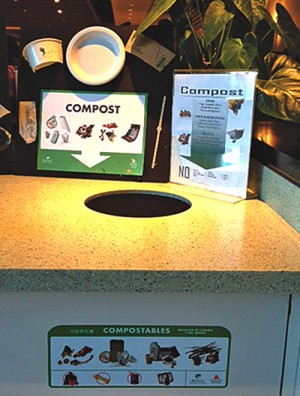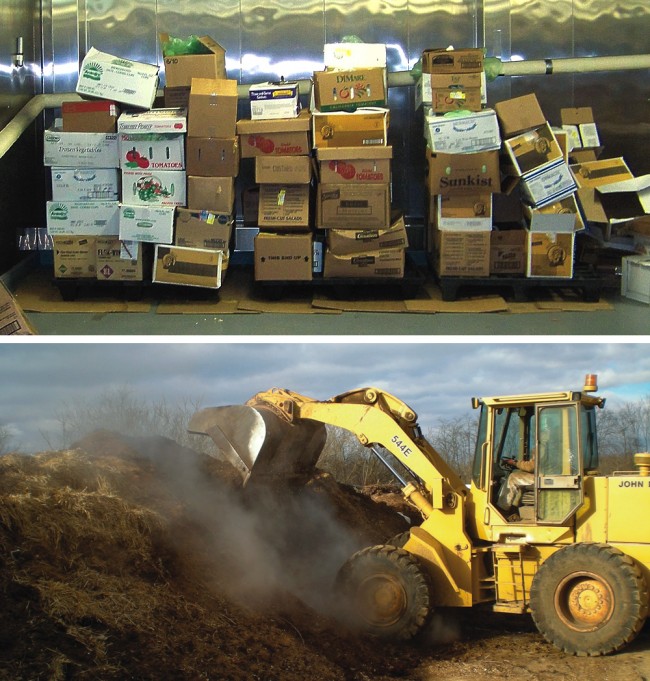General Services Administration facilities and Veteran Affairs medical centers are increasing source separation of food waste for diversion to composting.
Dan Emerson
BioCycle June 2013, Vol. 54, No. 6, p. 24

Some General Services Administration buildings collect postconsumer compostable waste from the cafeteria patron area and kitchenettes. A collection station is shown above.
Lena Kofas is the GSA’s national program coordinator for solid waste diversion and recycling. She works with a network of regional coordinators to promote sustainable waste management practices in GSA-managed federal buildings. Composting “is a relatively new component of the waste management services we provide,” Kofas says. By 2015, GSA has set a goal of diverting at least 50 percent of its nonhazardous solid waste, not including construction and demolition debris, from landfills and incinerators through reuse, recycling, composting and other methods. An audit of 150 GSA facilities nationwide showed that food waste and compostable packaging accounted for 28 percent of the total landfill waste stream, or more than 5,000 tons/year. “This shows us that there is a big opportunity to either reduce the amount of food waste generated or divert it to composting,” Kofas notes, adding that not all of GSA’s buildings have cafeterias or food service, and that they vary in size. In addition, the option for composting is “very location specific,” based on factors such as proximity of GSA buildings to facilities.
On a national level, GSA has started to incorporate food waste composting language (where feasible) into its contracts with custodial and cafeteria contractors. As an example, the Health and Sustainability Guidelines for Federal Concessions and Vending Operations encourage more sustainable food practices, such as composting and the purchase of compostable and biobased products, as well as food that is organically, locally and/or sustainably grown.
Currently, 29 GSA facilities are diverting food waste to composting, 16 of those in California. According to Kofas, programs vary at each facility. Some only divert preconsumer food waste segregated and collected in the kitchen prep area. Others also collect postconsumer compostable waste from the cafeteria patron area and kitchenettes. Most of these programs are source separating and sending the organics to local composters. In the first quarter of fiscal year 2013, GSA facilities composted 484 tons of food waste from the 29 buildings, about 6 percent of total waste diverted, Kofas says. Some landscape trimmings are included in the 484 tons. “However, this weight largely represents food-related waste since we focused on buildings with food waste composting,” she explains. “That’s a significant increase compared to previous years, which means composting programs are working.”
In California, combining a landscape and food compost collection program at the Los Angeles Federal Building has saved $3,180 in annual disposal costs (from $6,000 to $2,820), notes Guadalupe Novoa, Pacific Rim Regional Recycling Coordinator with the GSA’s Public Buildings Service in San Francisco. Trash service frequency was reduced and 432 tons of organics were diverted in FY2012.
In San Francisco, GSA Region 9 added composting at the Appraisers Building in May 2012. Separated organics include food scraps, plants and flowers, compostable plates, soiled napkins and paper towels. Compost bins are located in each kitchenette and break room area. Recology, the collection service provider, offers an incentive program where higher waste diversion results in a higher discount rate. GSA also negotiated with the custodial contractor to provide compostable bags at no extra cost to the agency. Composting resulted in an 11 percent increase in diversion at the Appraisers Building, from 45 percent in FY2011 to 56 percent in FY 2012.
VA Hospitals
One of the federal government’s most successful food waste reduction programs has been developed in West Virginia at the Martinsburg VA Medical Center. The Veterans Affairs (VA) facility has implemented a “Waste Watchers” project to improve compliance with EPA’s Food Recovery Hierarchy by implementing source reduction, food donation and composting. The medical center also has worked toward improving conservation of energy and water, and increased local food procurement practices and serving of sustainable foods and beverages. In April 2010, the Waste Watchers program won the VA Sustainability Award in the waste management category.

Food waste from the Martinsburg Veteran Affairs Medical Center is placed in 5-gallon biodegradable bags, which are then placed in cardboard boxes stacked on a pallet and stored in a corner of the kitchen’s freezer (top). The waste is collected biweekly and composted by Lyle C. Tabb & Sons in Kearneysville, West Virginia (above). Photos courtesy of Lyle C. Tabb & Sons
Food waste is picked up biweekly and composted by Lyle C. Tabb & Sons, Inc., a third-generation 1,800-acre crop-and-cattle family farm located about eight miles from the medical center. Tabb has been composting manure, yard trimmings, wood and food waste (including corrugated) since 1991. About 15,000 cubic yards of material are processed at a time. Two types of wood are accepted: natural, and clean pallets, or “white wood.” The white wood is ground into bedding and sold to horse operations. It is delivered in roll-off containers that remain at the farms to collect the soiled bedding — which then comes back to the Tabb farm to be composted. Natural wood is separated into firewood first, with stumps and limbs ground for mulch.
Compost windrows are turned with front-end loaders. Tabb has six different composting locations on his property, with a total area of about 10 acres. Most of those are located next to crop acreage to simplify spreading, since the farm uses at least 95 percent of what is produced for crop production, in lieu of commercial fertilizer. “All of the compost is at least 18 months-old before it’s applied,” explains Tabb. “We use some liquid nitrogen, so we’re not organic, but we feel we make a significant impact in our area in helping control phosphorous levels.” Some of the compost is mixed with mulch fines and sold. Currently, the VA medical center is Tabb’s only food waste customer, providing about 3 tons/month of material.
At the medical center, Hartman says one important piece of equipment is an automated, food waste tracking system made by LeanPath, Inc. It consists of a scale linked to a computer, to track the amount of kitchen food waste handled daily. “Tracking is important because it helps you to see where the waste is coming from, and helps you reduce it,” she explains. “You can get a (collection and composting) system in place, but you have to constantly monitor it, because the amount of waste fluctuates from day to day.” Hartman also emphasizes the importance of process improvement. “When you start a new process, you always want to be looking at how you can improve it. This kind of diversion project works really well in a hospital setting. It’s the front-line staff who make it happen. And having the will to make it happen is so important.”
By reducing the amount of food waste picked up for landfilling, Hartman estimates the hospital has saved “at least $40,000/year from our (2009) baseline; some have estimated it could be closer to $70,000/year.” The medical center has been able to use those funds to acquire higher-quality foods, specialty foods (such as locally grown raspberries) and other special meal items. Hartman would like to eventually expand to include the postconsumer food waste left over from daily meals; the medical center serves about 1,450 meals per day.
On Earth Day, April 22, Hartman and her staff decided to hold a one-day pilot to assess the willingness of patients who eat in the cafeteria to scrape their trays and deposit food waste in collection containers. They put up some 8.5 by 11-inches promotional signs to explain what to do. “We found that most of the veterans didn’t read our promotional signs and didn’t realize we were asking them to separate their waste while bussing the trays,” notes Hartman. “Our staff ended up doing this, but we found that it didn’t take more time to separate the scraps for composting since they do some separation anyway when preparing the wares for washing. Asking the veterans to separate food waste for one meal isn’t enough to make the ‘cultural’ switch. If we did this in the future, my sense is they would get used to the difference and be happy to comply.” About 70 pounds of food scraps were recovered, she adds.
Dan Emerson is a Contributing Editor to BioCycle.










